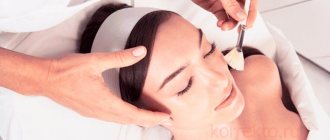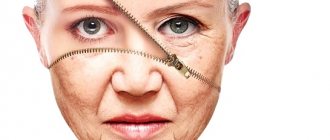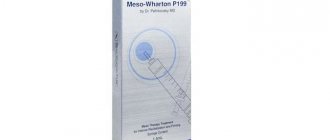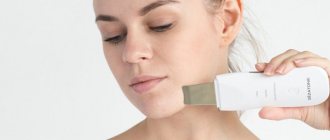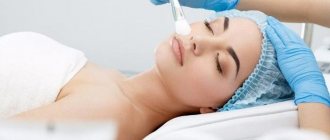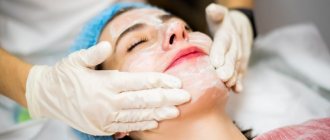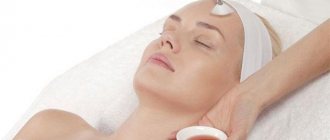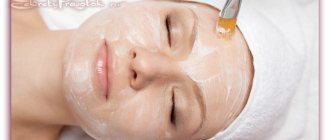Mechanical facial peeling
- one of the most aggressive types of peeling.
However, it is with its help that you can achieve impressive results. Depending on the strength of the impact on the upper layers of the skin, mechanical facial peels
are divided into superficial (manual or hardware brushing (or brossage), medium (microdermabrasion) and deep (dermabrasion).
Mechanical
, or hardware
peeling
this procedure is called because special devices are used to carry it out: a laser for laser peeling and an ultrasonic device for ultrasonic peeling.
>>
Description
The essence of the mechanical peeling
consists of cleansing the skin by removing or exfoliating the upper (partially or completely keratinized) layer of the epidermis using special cosmetic medications. This peeling is classified according to the degree of impact on the skin. This peeling can be light or deep. Light mechanical exfoliation is called brossage or gommage; and exfoliation, which has a deep effect, is microcrystalline. During exfoliation, the skin is “scraped” and old cells are removed, allowing the skin to regenerate and renew itself.
During mechanical peeling
use microbeads contained in scrubs.
Scrubs are special cosmetic creams that contain persistent particles (usually crushed plant seeds, sugar crystals, special crystalline salt formations, special cosmetic sand, etc.). In some cases, when carrying out a peeling procedure, scrub soap (with special abrasive particles) is used to clean the epidermis on the face or the dermis of the body from dead cells. For mechanical peeling,
scrubs are also used that contain crushed almond shells, pumice and other abrasive materials. Sometimes used as an abrasive, loofah. Exfoliation is carried out using fruit or glycolic acids. The mildest (superficial) peeling is carried out using alpha hydroxyl acids. These acids include malic acid, pyruvic acid, citric acid, and lactic acid.
Types of peelings by type of impact
According to the method of action on the skin in aesthetic cosmetology, there are 4 main types of peelings: mechanical, chemical, ultrasound and laser.
Mechanical peeling
Exfoliation of keratinized cells is carried out using abrasive substances that differ in fraction size. This can be sea salt, cane sugar, crushed nut shells, apricot bones, etc. Scrubs, gommages, and film masks are most often used to gently exfoliate dead cells. You can also achieve the effect of surface exfoliation using brossage or brushing.
If we talk about hardware procedures, microdermabrasion is considered the most common type of mechanical exfoliation. It is based on the use of special attachments with abrasives that grind the skin.113
Chemical peeling
It is based on the use of chemical acids that help exfoliate dead cells. The procedure is usually prescribed for wrinkles, acne, enlarged pores, signs of photoaging, and skin pigmentation. Chemical peels are most often performed using the following types of acids13:
- Pyruvic acid (PVC). It has keratolytic, sebostatic antimicrobial effects. Due to its low molecular weight, it can easily penetrate the skin. Used in superficial and medium peels. Clinical studies have shown the effectiveness of pyruvic acid in the correction of hyperkeratosis and post-inflammatory hyperpigmentation.
- Almond. The action is comparable to glycolic, but due to the fact that it has a higher molecular weight, it has a less irritating effect, and therefore the intensity of exfoliation is less. It has an antibacterial effect. It can be used on sensitive and thin skin.
- Salicylic. It has keratolytic, anti-inflammatory, antiseptic effects. Penetrates deep into the skin and is used in superficial and medium peels. During rehabilitation, large-plate peeling and moderate redness of the skin are observed.
- Azelaic. It has an antimicrobial effect, reduces the content of free fatty acids on the skin surface, and normalizes keratinization processes. Peels based on it are used to correct post-inflammatory hyperpigmentation.
Also used in cosmetology are ascorbic lactobionic, lactic, ferulic, malic, and other acids. In each case, the composition is selected in accordance with the condition of the skin and the problem that needs to be solved.
Ultrasonic peeling
Superficial exfoliation is carried out under the influence of ultrasonic radiation, which is produced by a special device. The waves are reflected from the surface of the skin and free the pores from impurities, cosmetic residues, and sebum. Thanks to the cavitation effect, the epidermis is effectively softened and loosened, which promotes effective cleansing.
Ultrasonic exfoliation is considered one of the most gentle. The device is configured in such a way that ultrasound waves penetrate to a depth of no more than 0.2 mm and eliminate only dead epidermal cells. The procedure allows you to thoroughly cleanse the skin with minimal discomfort, make it soft and velvety, smooth out wrinkles, and even out your complexion.
Considering the gentle effect of ultrasound waves, this type of exfoliation is often prescribed as part of complex anti-acne therapy. But the procedure can be carried out only in the absence of inflammatory elements, and no more than 1-2 times a month. Ultrasound peeling is often performed before other cosmetic procedures, such as massage, manual cleansing, mesotherapy, etc.77
Laser peeling
Laser peeling is considered one of the most popular hardware procedures. The technique is based on the use of laser radiation, which fights various skin defects (wrinkles, age spots, post-acne). There are several types of such peeling:
- Cold. It acts at the level of the visible part of the skin, removes dead epidermal cells layer by layer, but does not cause an increase in the temperature of the underlying structures.
- Hot. It acts at the level of the outer layer of the skin, promotes the removal of keratinized cells layer by layer, additionally warms the underlying structures, and stimulates cellular metabolism.
- Grinding. It acts at the level of the epidermis and dermis, completely destroys the old skin matrix, activates the processes of cellular regeneration, the synthesis of elastin and collagen.
The laser procedure improves the relief and structure of the skin, making it more elastic, soft, and radiant. With deep exposure, the laser helps smooth out pronounced wrinkles, eliminate scars and stretch marks.
As an alternative to a laser, a radio wave apparatus is sometimes used. Radio waves do the same thing as laser radiation. But they have a more gentle effect on the skin.
Regardless of the type of exfoliation chosen, to achieve a visible result, you will need to undergo a course of several procedures. Their number, as well as frequency, depends on the primary condition of the skin, existing problems, and the desired effect.189
Rehabilitation
After mechanical peeling, slight peeling or redness sometimes appears on the skin. This effect is natural. Its effect will stop after 7 days. For complex forms of mechanical peeling
and in case of hypersensitive skin, redness may be observed for several days after the mechanical exfoliation procedure, and capillary ruptures are also possible. The first time after peeling, it is not recommended to stay in the sun for a long time. To avoid uneven pigmentation, it is better to avoid visiting a solarium at first.
Enzyme peeling for face and body – what is it and when to use it?
Enzyme peels for the body or face usually contain plant enzymes, such as bromelain and papain. These ingredients dissolve dead epidermal cells and cleanse pores. They remove excess sebum from the skin, and also lighten age spots and relieve inflammation.
How to use enzyme peeling? The product is used as a regular mask, which in practice means that it is applied to the skin for 5-8 minutes. The peeling layer cannot be massaged. After rinsing off the scrub with warm water, do a light massage and apply a nourishing face cream. An intensely moisturizing mask is also suitable.
Enzyme peeling
Enzyme peeling, designed to be applied at night or during the day, has a very gentle effect and can be used for all skin types, especially problematic skin, such as acne-prone skin. It can also be used for sensitive and couperose skin, as well as for skin prone to redness. Information on how often to use a particular enzyme peel can be found on its packaging.
Result
As a result of mechanical peeling
the skin becomes clean, dead cells are removed from the surface of the skin, “giving way” to a young layer of skin. Peeling enhances the process of cell division (on the basal layer), and due to this the skin becomes smooth. As a result of mechanical exfoliation, the skin becomes uniform, healthy, and small pimples disappear. Peeling saturates the skin with oxygen, after which it absorbs cosmetics much better.
After exposure to abrasive particles, the skin is cleansed, healthier, and the disappearance of small facial wrinkles and acne is observed. The risk of their secondary occurrence is also reduced.
As a result of mechanical peeling
fine facial wrinkles are reduced, the skin becomes more even and smooth, blood microcirculation in the facial skin increases, as a result of which its protective properties increase, the skin tightens, the oval of the face becomes clearer.
Enzymatic or mechanical peeling?
Experts offer many facial scrubs, and sometimes it can be difficult to choose the best one. This could be, for example, enzyme peeling or mechanical peeling - coarse-grained or with small particles. Each of them has different properties and is intended for different skin types, so do not take risks with your choice, but ask your beautician which one is best for you.
The main task of any peeling is to exfoliate the dead layer of skin. Thanks to this, the skin is stimulated to produce new cells, which make it smooth, elastic and improve its overall condition. In addition, after using this type of cosmetics, the skin absorbs nutrients better.
Peeling depth
So what is the difference between mechanical peeling and enzyme peeling? First of all, they have different composition, consistency, method of application and mode of action. When choosing a peel, you should be guided mainly by your skin type and its needs.
Currently, mechanical peelings in the form of a gel with abrasive particles are popular on the market. Another type is a cream with abrasive ingredients, which is applied to washed skin, then spread with soft circular movements and washed off. There is also peeling in the form of a shower emulsion, which not only exfoliates the epidermis, but also moisturizes and cleanses the skin. You can use peeling with enzyme powder, which allows you to painlessly and deeply cleanse the skin.
What should not be done after the procedures?
Between sessions and for a week or two after the course, you will have to adhere to some restrictions. These include:
- avoiding tanning, direct sunlight, solarium sessions,
- using sunscreen in intense sun,
- abstaining from decorative cosmetics, scrubs, as well as preparations containing lactic or other acids,
- avoiding intense physical activity and sports (to avoid increased sweating and the irritating effects of sweat).
What effect do procedures at A Clinic give?
The maximum effect is achieved after 5-6 microdermabrasion procedures using the Maya Peel Plus device:
- the skin becomes smooth and silky, firm and elastic,
- skin color evens out, becomes healthy,
- the skin is well cleansed of all impurities,
- natural skin renewal processes are activated,
- the aging process slows down,
- small wrinkles are smoothed out,
- the skin looks rested and toned.
The effect of microdermabrasion is noticeably felt after the first procedure at A Clinic. Subsequent sessions strengthen and consolidate this effect.
Benefits of microdermabrasion at A-Clinic
1. The Maya Peel Plus device is equipped with a double flow filtration system.
This guarantees a completely controlled effect. 2. Microdermabrasion procedures at the A Clinic are completely painless; they do not require anesthesia or the use of cooling systems.
3. Highly controlled air flow provides an optimal combination of efficiency and comfort.
4. Individual setting of parameters guarantees uniform treatment over the entire area with the same depth of impact. This gives the effect of perfectly smooth skin.
5. Exposure to vacuum during microdermabrasion powerfully activates metabolism in the surface layers. This stimulates natural restoration and renewal - regeneration at the cellular level.
A positive side effect of the procedure is the activation of fibroblasts that synthesize collagen. This is manifested by the fact that the content of collagen and elastin increases, and the skin tightens.
6. The Maya Peel Plus microdermabrasion technique is universal. It is used not only on the face (including delicate areas of the eyelids), but also on the neck, hands and other areas.
Restorative care
After the Hollywood peeling, it is strictly not recommended to peel off the resulting crusts or apply makeup for five or six days. You can't sunbathe or visit a solarium for a month. The next day after the procedure, the skin is irrigated with thermal water every few hours. You can start regular care on the third day. However, you should wash your face carefully, with slightly warm water with cleansing foam or a slightly acidic composition. Afterwards, apply panthenol-based ointment. For subsequent care, creams enriched with moisturizing components and antioxidants are suitable. Before leaving the room, use a highly effective sunscreen emulsion.
Thus, Hollywood peeling is a highly effective anti-aging, antibacterial and whitening procedure. According to the rules, it is carried out with a preparation from the same parts of resorcinone, lactic, and salicylic acid. Less commonly, the composition is enriched with citric or glycolic acid, and the lactic content also increases. Hollywood peeling is a moderate version of exfoliation, so the recovery period after it lasts no more than two weeks.
Surely you may still have questions that our VBG Cosmetic specialists will answer with great pleasure.
